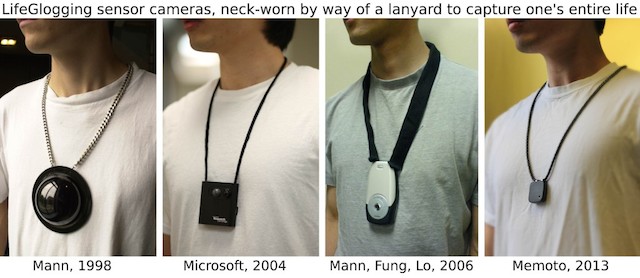Steve Mann is a tenured professor at the Department of Electrical and Computer Engineering at the University of Toronto and also the General Chair for the IEEE ISTAS13 conference in Toronto 27-29th June 2013, http://veillance.me – where Memoto’s CEO will be a speaker. Mann is considered the “father of wearable computing.” He is featured in the upcoming documentary, Lifeloggers.
How Steve Mann became the “father of wearable computing”
I began with something I called “Digital Eye Glass” to help people see better. This was inspired by a childhood fascinating with welding, and electric discharge, lighting, etc., to be able to see extreme dynamic range and extreme lighting situations such as extreme electronic flash and extreme electric arc discharge lamps, etc., together with computer overlays, i.e. Augmediated Reality. After I developed the Generation-1 Digital Eye Glass in 1980, with graphics and text overlays from a 6502 microprocessor-based computer with NTSC output, another company, 3M, came up with something called “SpeedGlas” or “SpeedGlass,” in 1981, which helps people see better by globally darkening the entire glass, but not in a way that allows one to discern any spatial variation — their glass darkened completely over its entire field-of-view. My Eye Glass helped the wearer see better by processing video imagery and re-displaying it for better eyesight.
While wearing the Eye Glass in everyday life, I found I was being stopped by security guards concerned that I might be taking pictures. At the time computers did not have enough capacity to even store a single image in its entirety. In 1980 my entire wearable computer had only 64k of RAM == not enough store even a single frame of video.
But these encounters with paranoid security guards got me thinking about “Veillance” because it seemed that the only places I was having problems wearing a computerized seeing aid were places that had surveillance cameras. Back in those days surveillance cameras were very rare, but they were starting to appear in more and more places, and I was starting to be harassed by security guards in more and more places for merely wearing a vision aid.
The beginning of sousveillance
So I began thinking about “surveillance” and formulated a theory that what I was wearing was the reciprocal of surveillance, i.e. inverse surveillance.
In Canada where I was born, most people speak some French, “surveillance” is a French word that means “watching from above” or “watching over” or “overwatching.” “Veillance” means “watching” or “monitoring” or “sight”, and “sur” means “over” or “from above”. So I referred to my vision aid as a “sousveillance” device, from the French prefix “sous” which means “below,” “beneath,” or “under,” as in “sous-chef” or “sous la table” (under the table).
Somehow my invention (the sousveillance device) gets along with surveillance like antimatter gets along with matter, i.e. conflict. And since surveillance was growing greatly, it seemed so was the opposition to sousveillance by officials of the “surveillance superhighway” quickly growing throughout our country.
In 1992 I was accepted at MIT (Massachusetts Institute of Technology in the U.S.) and brought my invention to the MIT Media Lab to found the “MIT Wearable Computing Project.” Here’s a short video with an interview of the Director of the MIT Media Lab, Nicholas Negroponte, explaining how this all started: http://www.glogger.mobi/v/75560
In 1993 with the introduction of the World Wide Web, I did something fun and interesting. I created something I called “Wearable Wireless Webcam” and put my Eye Glass online streaming live video to the then new World Wide Web. By 1995, I was on “Cool Site of the Day,” which, at the time, was the world’s largest web portal. http://wearcam.org/eastcampusfire and here’s an article someone wrote criticizing my invention: http://tech.mit.edu/V116/N28/mann.28c.html
By 1998 I had miniaturized this technology in a neckworn pendant containing a camera with fisheye lens and various sensors; see http://www.glogger.mobi/v/199679. This creates something I called a “LifeGlog,” a lifelong “glog.”
Lifeglogging
“Glog” is short for “CYBORGlog” in the same way that “Blog” is short for “WEBlog”. A lifeglog is a lifelong cyborglog, i.e. a log that does not take conscious thought or effort to generate. A weblog requires thought or effort to write. A lifelog can be for example, a handwritten diary kept over one’s entire life, whereas a lifeglog is generated automatically by machine.
I made the design (of the sousveillance device) to mimick the appearance of the surveillance cameras in the world around me. In this way it takes on a familiar aesthetic but artistically a detournement, re-situating these familiar objects in a different way.
Lessons from lifeglogging
Glogging has taught me a lot about other people. One thing I learned is about integrity. Surveillance embodies a kind of hypocrisy: “we’re going to watch you but you’re not allowed to watch us.” (See http://www.glogger.mobi/v/180231) The opposite of surveillance is sousveillance. The opposite of hypocrisy is integrity. In some sense, therefore, the sousveillance necklace is a kind of “honesty pendant” that focuses on integrity and diminishes, or challenges, hypocrisy.
Sousveillance teaches us a lot about human nature, honesty, integrity, corruption, and the like. Most notably, the lines between surveillance and sousveillance are being blurred, and I look forward to seeing companies like Memoto bring forth a “Veillance” society that challenges the “Sur” in “Sur-Veillance.”
Interested in learning more about Lifelogging? Visit http://lifeloggersmovie.com for more information.



2 Comments
There is so much to the history of Steve Mann’s inventions that can inform how we have arrived to where we are today with Digital Glass. This needs to be acknowledged by those in industry and academe alike. My personal interests especially ponder on the social implications of emerging technologies that we might “bear” for convenience solutions, and not just “wear”. What will it mean to “put on” the camera? Steve’s participant observer status has given him a birds eye view of first person interactions of which he has shared in this interview with Memoto some critical insights. We have much to learn from these early inventor/adopters about the social-ethical implications that might be the source of public complexity.
Professor Steve Mann is also the General Chair for the IEEE ISTAS13 conference in Toronto 27-29th June 2013 – http://www.istas13.org or http://veillance.me – where Martin Kalstrom from Memoto will also be an invited speaker.